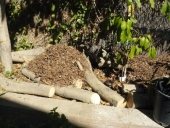posted 13 years ago
Ok, after quite a bit of mulling over hugelkulter for a while, I'm starting to see some potential, but I need some input specific to my site. Let me start by describing my site.
Much of the 20 inches of rain falls in the form of snow across 4 or 5 months, a significant portion also falls as rain in the spring, but killing frosts happen all the way into early June. Summer, or the season that has no killing frosts, lasts sometimes as little as 80 days and brings an average of 3 inches of rain, temps in the 80's and 90's and humidity in the teens. Fall, the time between the first killing frost and the first snow is about 6 weeks long.
The ground is an former farm field. Over 400 feet it only drops about 10 feet toward the south. There is about 12 inches of sandy alkaline topsoil on top of about 40 feet of sand and gravel. There is no clay! Sure I know somebody out there is just itching to tell me that vast majority of all ground has clay in it, but I'm telling you now, we dug a hole big enough to see from space next door and there was no clay. Over the snow season the top soil turns into frozen mud that is the consistency of brick until early spring when in turns into pudding until the thaw completes. Once the thaw completes the water quickly vanishes into the ground.
I'm currently growing a lot of Knapp weed as I keep forgetting to water my garden. I working on dividing up the property into paddocks for chickens as their acidic manure is good for alkaline soil. I am also working on some Honey and Black locust trees.
Now given that Missoula has a very similar, if less snowy, weather pattern, I know I should benefit from hugelkulter, but:
Should the hugelkulter beds go east and west? North to south? Up and down hill? Cross hill? I was thinking of running the hugelkulter beds eat and west cross hill with little bends on either end to catch run off.
Do I still get a benefit if I strip off the top soil, put down a foot of wood debris, and then put the top soil back on? Or is my soil so crappy I shouldn't worry and I should go ahead and pile the sand onto the hugelkulter beds?
We have a lot of lodge pole pine in the area that nobody seam to care about much, so I may be able to get some of it cheap. Any foreseeable problems there?









